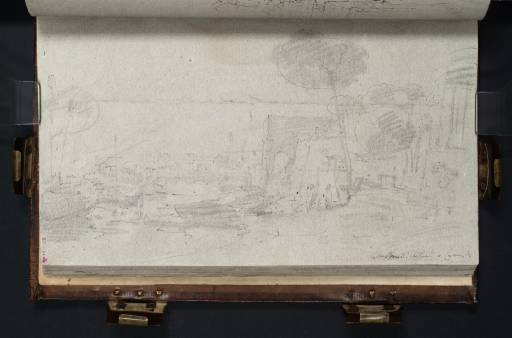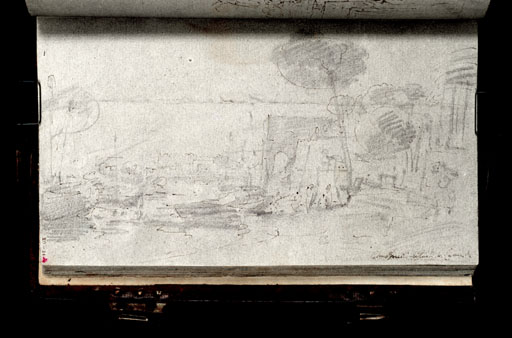Joseph Mallord William Turner The Return of Chryseis 1805
Image 1 of 2
Joseph Mallord William Turner,
The Return of Chryseis
1805
Joseph Mallord William Turner 1775–1851
Folio 34 Recto:
The Return of Chryseis 1805
D05541
Turner Bequest XC 34
Turner Bequest XC 34
Pencil, pen and ink and white chalk on off-white wove paper, prepared with a grey wash, 150 x 258 mm
Inscribed by Turner in ink ?‘Chryseis returning to Chryses’ bottom right
Inscribed by John Ruskin in red ink ‘34’ bottom left, descending vertically
Stamped in black ‘XC 34’ bottom left, descending vertically
Inscribed by Turner in ink ?‘Chryseis returning to Chryses’ bottom right
Inscribed by John Ruskin in red ink ‘34’ bottom left, descending vertically
Stamped in black ‘XC 34’ bottom left, descending vertically
Accepted by the nation as part of the Turner Bequest 1856
References
1909
A.J. Finberg, A Complete Inventory of the Drawings of the Turner Bequest, London 1909, vol.I, p.235, XC 34, as ‘Study for an historical subject – “Chr... returning to Cyn...”’.
1974
Gerald Wilkinson, The Sketches of Turner, R.A. 1802–20: Genius of the Romantic, London 1974, p.109 reproduced in colour.
1990
Kathleen Nicholson, Turner’s Classical Landscapes: Myth and Meaning, Princeton 1990, pp.268, 308 reproduced pl.6.
1993
David Hill, Turner on the Thames: River Journeys in the Year 1805, New Haven and London 1993, p.161, as ‘Study for an embarkation or landing scene’.
For the various versions in this sketchbook of an ancient seaport with figures embarking or landing, see note to folio 1 (D05491). This composition is similar to one facing it on folio 33 verso (D05540) and there is a coloured version on folio 38 verso (D05550). For Hill, the foreground ‘seems Carthaginian, but the distance more like the Thames at Richmond’. Another classical transposition of Richmond scenery is on folio 33 (D05539).
Finberg’s reading of Turner’s inscription is expanded, surely correctly, by Nicholson in a discussion of Turner’s subjects from Homer’s Iliad. She sees Turner’s focus on the story of Chryses and Chryseis in Book 1 as characteristic of his sympathy with the victims of war and with ‘helplessness in the face of unreasonable forces’. Chryseis (or Astynome), daughter of Chryses, a priest of Apollo, is taken as booty by the Greeks, causing him much anguish; she is returned following his direct appeal to the god, who sends a plague upon her captors, and the intervention of Ulysses. Here, Turner seems to have sketched an idea for her restitution, while in his notes on a further coloured study of a slightly different seaport on folio 49 verso (D05568) he gave ‘Ulysses ... [arrival] at Cryse’ as one possibility for its subject, meaning Ulysses’s return of the captive girl; and on the facing page, folio 59 (D05569), further options include ‘Ulysses with Chryseis offering her to her Father’. Nicholson observes Turner’s fidelity to the poem in his introduction of Ulysses, and also to the artistic precedent of Claude’s Seaport with Ulysses Restituting Chryseis (Louvre, Paris) which he could have seen in Paris in 1802 or perhaps knew in reproduction.
David Blayney Brown
August 2007
How to cite
David Blayney Brown, ‘The Return of Chryseis 1805 by Joseph Mallord William Turner’, catalogue entry, August 2007, in David Blayney Brown (ed.), J.M.W. Turner: Sketchbooks, Drawings and Watercolours, Tate Research Publication, December 2012, https://www


